Click on images to enlarge
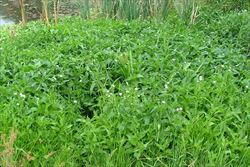
infestation (Photo: Sheldon Navie)
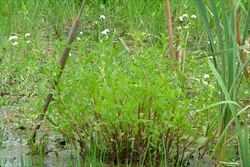
habit (Photo: Sheldon Navie)
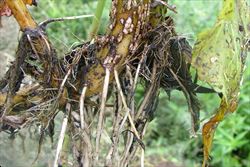
stem with adventitious roots (Photo: Sheldon Navie)
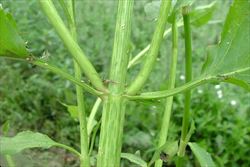
upper stem with branches (Photo: Sheldon Navie)

oppositely arranged leaves with toothed margins (Photo: Sheldon Navie)
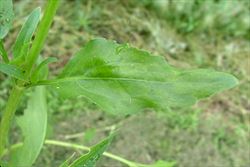
close-up of leaf (Photo: Sheldon Navie)

flower-heads (Photo: Sheldon Navie)
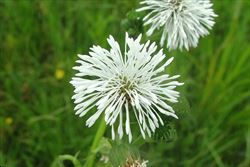
close-up of flower-head showing numerous elongated style branches (Photo: Sheldon Navie)
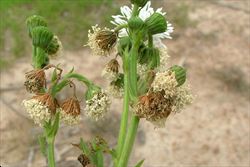
old and young flower-heads (Photo: Sheldon Navie)
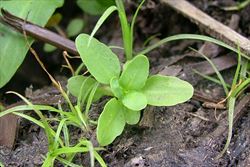
seedling (Photo: Sheldon Navie)
Scientific Name
Gymnocoronis spilanthoides (D. Don ex Hook. & Arn.) DC.
Family
Asteraceae (Queensland, New South Wales, the ACT, Victoria, Tasmania, Western Australia and the Northern Territory)
Compositae (South Australia)
Common Names
Senegal tea,
Origin
Native to South America (i.e. Brazil, Bolivia, Peru, Argentina, Paraguay and Uruguay) and possibly also Mexico.
Cultivation
This species has been widely cultivated as an aquarium or ornamental water plant in Australia.
Naturalised Distribution
Not yet widely naturalised, and currently restricted to isolated outbreaks in some parts of eastern Australia. It has been reported from south-eastern Queensland, the coastal districts of northern and central New South Wales, and is sparingly naturalised in central Victoria.
Also known to be naturalised in India, Hungary and New Zealand.
Habitat
A weed of wetter tropical, sub-tropical and warmer temperate environments. It is particularly problematic along waterways, around lakes and dams, in swamps and wetlands, and along drains and channels.
Habit
A long-lived (i.e. perennial) herbaceous plant that grows on damp ground or partially covered by water (i.e. a terrestrial or emergent aquatic herb). It forms a rounded bush (1-2.5 m tall) in more terrestrial habitats and a mat of tangled branches extending out over the water surface in aquatic habitats.
Distinguishing Features
- an aquatic plant, either forming a rounded bush or a tangled mass of vegetation along waterways.
- its stems (up to 20 mm thick) are hollow between the joints and its leaves are arranged in opposite pairs.
- these leaves are somewhat elongated in shape (4-20 cm long and 1.5-8 cm wide) and have toothed margins.
- its flower-heads are fluffy in appearance (12-20 mm across), white or pale purplish-white in colour, and arranged in small dense clusters at the tips of the leafy branches.
- its yellowish-brown 'seeds' (about 5 mm long) are ribbed and hairless.
Stems and Leaves
The stems are initially upright (i.e. erect), but often gradually become low-groing or creeping (i.e. decumbent or prostrate), especially when growing out over the water surface. Younger stems are pale green in colour with darker blotches. These stems (5-20 mm thick) are initially rounded in cross-section, but as they mature they become ribbed or six-sided in cross-section. Many side (i.e. lateral) branches are produced at the the stem joints (i.e. nodes) and this eventually leads to the formation of a tangled mat of stems. The stems are hollow between the joints and this aids their buoyancy in water.
The are dark green leaves are oppositely arranged along the stems and borne on short stalks (i.e. petioles). These leaves (4-20 cm long and 1.5-8 cm wide) are quite variable in size and shape, with blades that range from egg-shaped in outline (i.e. ovate) to lance-shaped (i.e. lanceolate). They are hairless (i.e. glabrous), with toothed (i.e. serrated) margins and pointed tips (i.e. acuminate apices).
Flowers and Fruit
The flower-heads (i.e. capitula) are white or pale purplish-white in colour and fluffy in appearance. These flower-heads (12-20 mm across) are borne on short stalks (i.e. peduncles) and arranged into small dense clusters at the ends of the branches (i.e. in terminal corymbs). They have no obvious 'petals' (i.e. ray florets) and are surrounded at the base by one, or occasionally two, rows of green bracts (i.e. an involucre) 4-5 mm long. Each flower-head (i.e. capitulum) is actually made up of numerous tiny white flowers (i.e. tubular florets). These tiny flowers (about 4 mm long) have both male and female parts, and the two branches of the style are elongated with club-shaped tips (these may be mistaken for very narrow 'petals'). Flowering usually occurs from late spring through until late autumn (i.e. from November to May).
The 'seeds' (i.e. achenes) are ribbed lengthwise, hairless (glabrous), and yellowish-brown in colour. They are about 5 mm long and there are no scales or bristles at the top of the seeds (i.e. they do not have a 'pappus').
Reproduction and Dispersal
This plant reproduces by seed and roots are readily produced at the joints (i.e. nodes) along the stems, enabling new plants to grow from stem fragments.
The seeds and stem fragments are dispersed by water and in dumped aquarium waste. Seeds are also spread in mud attached to animals and vehicles.
Environmental Impact
Senegal tea plant (Gymnocoronis spilanthoides) is regarded as an environmental weed in Queensland and New South Wales, and as a potential environmental weed or "sleeper weed" in other parts of Australia. Its distribution is relatively limited at present, but it is on the Alert List for Environmental Weeds, a list of 28 non-native plants that threaten biodiversity and cause other environmental damage.
This aquatic plant grows out over the surface of slow-moving or stationary water bodies and can form dense, floating mats of vegetation. It grows very quickly in fertile environments, with growth rates exceeding 15 cm a week being reported. Senegal tea plant (Gymnocoronis spilanthoides) will invade and degrade natural wetlands and waterways by competing strongly with slower growing native plants. It will eventually replace the native plants, thereby also affecting the birds and other animals that are dependent upon them for food and shelter. Hence, Senegal tea plant (Gymnocoronis spilanthoides) poses a significant threat to the health of entire wetland ecosystems.
This species is currently of most concern in south-eastern Queensland and eastern New South Wales, but it has the potential to become a major weed of wetlands throughout much of Australia. In south-eastern Queensland, where it is ranked among the top 50 most invasive plant species, several relativelt large infestations are being actively managed. While in New South Wales, Senegal tea plant (Gymnocoronis spilanthoides) is currently mainly a problem in the region between Taree and Dapto.
Other Impacts
Senegal tea plant (Gymnocoronis spilanthoides) infestations block waterways and drainage channels, and can therefore increase the damage caused by flooding. They can also impede recreational activities, interfere with irrigation and restrict navigation of waterways. Water quality may also be affected by this weed, particularly if large amounts of Senegal tea plant (Gymnocoronis spilanthoides) die off and rot under water.
Legislation
This species is declared under legislation in the following states and territories:
- ACT: C1 - notifiable pest plant (a pest plant whose presence must be notified), and C4 - prohibited pest plant (a pest plant whose propagation and supply is prohibited).
- New South Wales: Class 1 - a state prohibited weed. The presence of the weed on land must be notified to the local control authority and the weed must be fully and continuously suppressed and destroyed (throughout the entire state).
- Queensland: Class 1 - introduction into the state is prohibited, and landowners must take reasonable steps to keep land free of this species (throughout the entire state). It is also illegal to sell a declared plant or its seed in this state.
- South Australia: 1@ - this species is declared under Class 1a, a classification for prohibited aquatic plants. Its presence must be notified and the plant must be destroyed (throughout the entire state).
- Tasmania: D - the importation or sale of this species is prohibited and measures to reduce its population in an area, eradicate it from an area, or restrict it to a particular area may be required.
- Western Australia: P1 - trade, sale or movement into the state prevented, and P2 - to be eradicated (throughout the entire state).
Management
For information on the management of this species see the following resources:
- the Biosecurity Queensland Fact Sheet on this species, which is available online at http://www.dpi.qld.gov.au.
Similar Species
Senegal tea plant (Gymnocoronis spilanthoides) may be confused with hygrophila (Hygrophila costata), and occasionally also with Siam weed (Chromolaena odorata), crofton weed (Ageratina adenophora) and mistflower (Ageratina riparia). These species can be distinguished by the following differences:
- Senegal tea plant (Gymnocoronis spilanthoides) is a semi-aquatic plant with somewhat hollow stems and narrowly egg-shaped (i.e. ovate) or lance-shaped (i.e. lanceolate) leaves with finely toothed (i.e. serrate) margins. Its relatively large flower-heads (12-20 mm across) are white or pale purplish-white in colour and borne in small clusters at the tips of the branches.
- hygrophila (Hygrophila costata) is a semi-aquatic plant with stems that are not hollow and leaves with entire margins. Its whitish-coloured flowers are tubular in shape (about 10 mm long), stalkless (i.e. sessile), and borne in small clusters in the leaf forks (i.e. axils).
- Siam weed (Chromolaena odorata) is a large terrestrial plant with stems that are not hollow and egg-shaped (i.e. ovate) or triangular leaves with slightly toothed (i.e. serrate) margins. Its relatively small flower-heads (about 3 mm across) are pale pink, mauve or whitish in colour and borne in dense clusters at the tips of the branches.
- crofton weed (Ageratina adenophora) is an upright (i.e. erect) terrestrial plant (1-2 m tall) with stems that are not hollow and relatively broad leaves with slightly toothed (i.e. crenate or serrate) margins. Its relatively small flower-heads (5-7 mm across) are white in colour and borne in dense clusters at the tips of the branches.
- mistflower (Ageratina riparia) is a creeping (i.e. decumbent) or scrambling terrestrial plant (40-60 cm tall) with stems that are not hollow and relatively narrow leaves with toothed (i.e. serrate) margins. Its relatively small flower-heads (about 5 mm across) are white in colour and borne in dense clusters at the tips of the branches.

